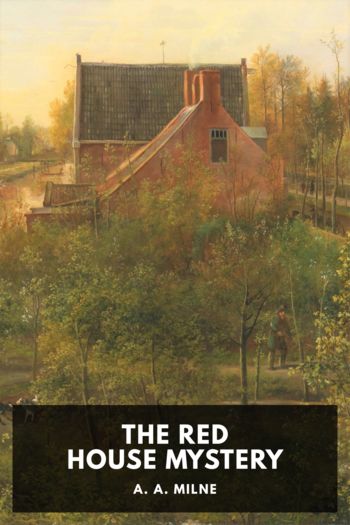Short Fiction Edgar Allan Poe (books for men to read .txt) 📖

- Author: Edgar Allan Poe
Book online «Short Fiction Edgar Allan Poe (books for men to read .txt) 📖». Author Edgar Allan Poe
New York Journal of Commerce. ↩
Philadelphia Saturday Evening Post, edited by C. I. Peterson, Esq. ↩
Adam ↩
See “Murders in the Rue Morgue.” ↩
The New York Commercial Advertiser, edited by Col. Stone. ↩
“A theory based on the qualities of an object, will prevent its being unfolded according to its objects; and he who arranges topics in reference to their causes, will cease to value them according to their results. Thus the jurisprudence of every nation will show that, when law becomes a science and a system, it ceases to be justice. The errors into which a blind devotion to principles of classification has led the common law, will be seen by observing how often the legislature has been obliged to come forward to restore the equity its scheme had lost.”
—Landor↩
New York Express. ↩
New York Herald. ↩
New York Courier and Inquirer. ↩
Mennais was one of the parties originally suspected and arrested, but discharged through total lack of evidence. ↩
New York Courier and Inquirer. ↩
New York Evening Post. ↩
New York Standard. ↩
Of the Magazine in which the article was originally published. ↩
The coralites. ↩
“One of the most remarkable natural curiosities in Texas is a petrified forest, near the head of Pasigno river. It consists of several hundred trees, in an erect position, all turned to stone. Some trees, now growing, are partly petrified. This is a startling fact for natural philosophers, and must cause them to modify the existing theory of petrification.
—KennedyThis account, at first discredited, has since been corroborated by the discovery of a completely petrified forest, near the head waters of the Cheyenne, or Chienne river, which has its source in the Black Hills of the rocky chain.
There is scarcely, perhaps, a spectacle on the surface of the globe more remarkable, either in a geological or picturesque point of view than that presented by the petrified forest, near Cairo. The traveller, having passed the tombs of the caliphs, just beyond the gates of the city, proceeds to the southward, nearly at right angles to the road across the desert to Suez, and after having travelled some ten miles up a low barren valley, covered with sand, gravel, and sea shells, fresh as if the tide had retired but yesterday, crosses a low range of sandhills, which has for some distance run parallel to his path. The scene now presented to him is beyond conception singular and desolate. A mass of fragments of trees, all converted into stone, and when struck by his horse’s hoof ringing like cast iron, is seen to extend itself for miles and miles around him, in the form of a decayed and prostrate forest. The wood is of a dark brown hue, but retains its form in perfection, the pieces being from one to fifteen feet in length, and from half a foot to three feet in thickness, strewed so closely together, as far as the eye can reach, that an Egyptian donkey can scarcely thread its way through amongst them, and so natural that, were it in Scotland or Ireland, it might pass without remark for some enormous drained bog, on which the exhumed trees lay rotting in the sun. The roots and rudiments of the branches are, in many cases, nearly perfect, and in some the wormholes eaten under the bark are readily recognizable. The most delicate of the sap vessels, and all the finer portions of the centre of the wood, are perfectly entire, and bear to be examined with the strongest magnifiers. The whole are so thoroughly silicified as to scratch glass and are capable of receiving the highest polish.
—Asiatic Magazine↩
The Mammoth Cave of Kentucky. ↩
In Iceland, 1783. ↩
“During the eruption of Hecla, in 1766, clouds of this kind produced such a degree of darkness that, at Glaumba, which is more than fifty leagues from the mountain, people could only find their way by groping. During the eruption of Vesuvius, in 1794, at Caserta, four leagues distant, people could only walk by the light of torches. On the first of May, 1812, a cloud of volcanic ashes and sand, coming from a volcano in the island of St. Vincent, covered the whole of Barbados, spreading over it so intense a darkness that, at midday, in the open air, one could not perceive the trees or other objects near him, or even a white handkerchief placed at the distance of six inches from the eye.”
—Murray, p. 215, Phil. edit.↩
“In the year 1790, in the Caraccas during an earthquake a portion of the granite soil sank and left a lake eight hundred yards in diameter, and from eighty to a hundred feet deep. It was a part of the forest of Aripao which sank, and the trees remained green for several months under the water.”
—Murray, p. 221↩
The hardest steel ever manufactured may, under the action of a blowpipe, be reduced to an impalpable powder, which will float readily in the atmospheric air. ↩
The region of the Niger. See Simmona’s Colonial Magazine. ↩
The Myrmeleon—lion-ant. The term “monster” is equally applicable to small abnormal things and to great, while such epithets as “vast” are merely comparative. The cavern of the myrmeleon is vast in comparison with the hole of the common red ant. A grain of silex is also a “rock.” ↩
The Epidendron, Flos Aeris, of the family of the





Comments (0)